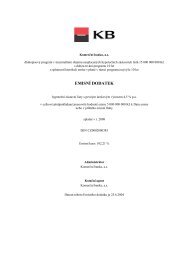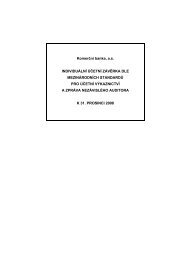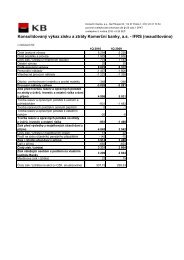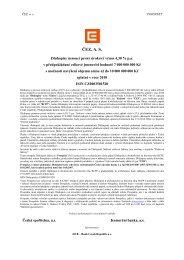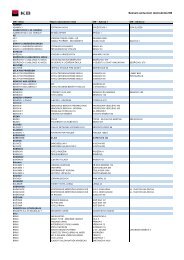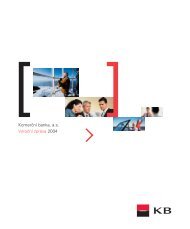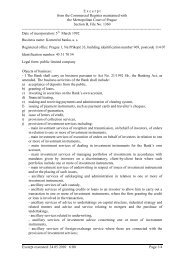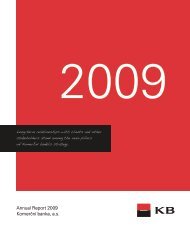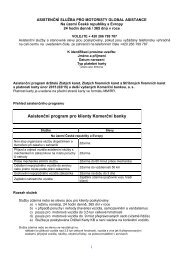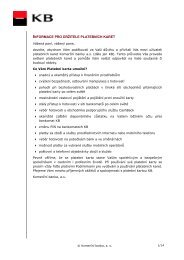KB prezent. angl - Komerční banka
KB prezent. angl - Komerční banka
KB prezent. angl - Komerční banka
Create successful ePaper yourself
Turn your PDF publications into a flip-book with our unique Google optimized e-Paper software.
(b) Basis of consolidation<br />
Subsidiary undertakings, which are those companies in which the Bank, directly or indirectly, has an interest of more than one half of<br />
the voting rights or otherwise has power to exercise control over the operations, have been fully consolidated. Subsidiaries are<br />
consolidated from the date on which effective control is transferred to the Bank and are no longer consolidated from the date of<br />
disposal. All intercompany transactions have been eliminated.<br />
Investments in unconsolidated subsidiaries are recognised in the consolidated balance sheet at cost less any provisions.<br />
Investments in associated undertakings are accounted for using the equity method of accounting. These are undertakings in which<br />
the Group has between 20 percent and 50 percent of the voting rights, and over which the Group exercises significant influence, but<br />
which it does not control. Equity accounting involves recognising in the profit and loss statement the Group’s share of the associates‘<br />
profit or loss for the period. The Group interest in the associate is carried in the balance sheet at an amount that reflects its share of<br />
net assets of the associate and includes goodwill on acquisition.<br />
(c) Foreign currency translation<br />
Assets and liabilities denominated in foreign currencies are translated into CZK and reported in the financial statements at the<br />
exchange rate declared by the Czech National Bank (“CNB”) prevailing as of the balance sheet date. Income and expenses<br />
denominated in foreign currencies are recorded in Czech Crowns in the underlying accounting system of the Group and are therefore<br />
reported in the financial statements at the official exchange rate prevailing as of the date of the transaction. Gains and losses arising<br />
from movements in exchange rates after the date of the transaction are recognised in Net profit/(loss) on financial operations. Net<br />
gains on the revaluation of fixed asset investments are recorded as a component of equity in Revaluation reserve.<br />
(d) Originated loans and provisions for loan impairment<br />
Loans originated by the Group by providing money directly to a borrower are categorised as loans originated by the Group and are<br />
carried at amortised cost. All loans and advances are recognised when cash is advanced to borrowers.<br />
Loans and advances to customers and financial institutions are stated net of provisions for loan losses. Further details about<br />
provisioning are set out in Note 38 to these financial statements.<br />
The Group charges penalty interest to borrowers when a portion of the loan falls overdue. Pursuant to the Group’s policies, penalty<br />
interest is not covered by the collateral set aside against the loan of the borrower. Penalty interest is accounted for on a cash basis in<br />
Interest income.<br />
The Group maintains a general provision for losses arising from on and off balance sheet loan exposures. A portion of the general<br />
provision relating to on balance sheet assets is established to cover losses that are judged by the management of the Group to be<br />
present in the loan portfolio as of the balance sheet date, but which have not been allocated to specific or individual exposures.<br />
The Group writes off loss loans when clients are unable to fulfil their obligations to the Bank in respect of these loans. The loan is<br />
written off against the related provision for loan impairment. Subsequent recoveries are credited to the profit and loss statement in<br />
Provision for loan losses if previously written off.<br />
(e) Securities<br />
Securities held by the Group are categorised into portfolios in accordance with the Group’s intent on the acquisition of the securities and<br />
pursuant to the Group’s security investment strategy. The Group has allocated securities to the Held for trading portfolio, the Available<br />
for sale portfolio and the Held to maturity portfolio. With effect from 2002, the Group has also carried securities in the category Acquired<br />
under initial offerings not designated for trading which are reported together with loans. The principal difference among the portfolios<br />
relates to the measurement approach of securities and the recognition of their fair values in the financial statements.<br />
All securities held by the Group are recognised using settlement date accounting and are measured at cost which, for coupon bonds,<br />
includes amortised cost, accrued coupon and an element of direct transaction costs associated with the acquisition of securities. All<br />
purchases and sales of securities that do not meet the “regular way” settlement criterion (that is, within the time frame established<br />
generally by regulation or convention in the market place concerned) are treated as financial derivatives and are recognised on the<br />
face of the balance sheet upon settlement at fair value. The cost of debt securities is increased to reflect the accrued interest income<br />
using the effective interest rate method. Interest income includes the accrued coupon and the accrued difference between the<br />
nominal value of the security and its cost.



